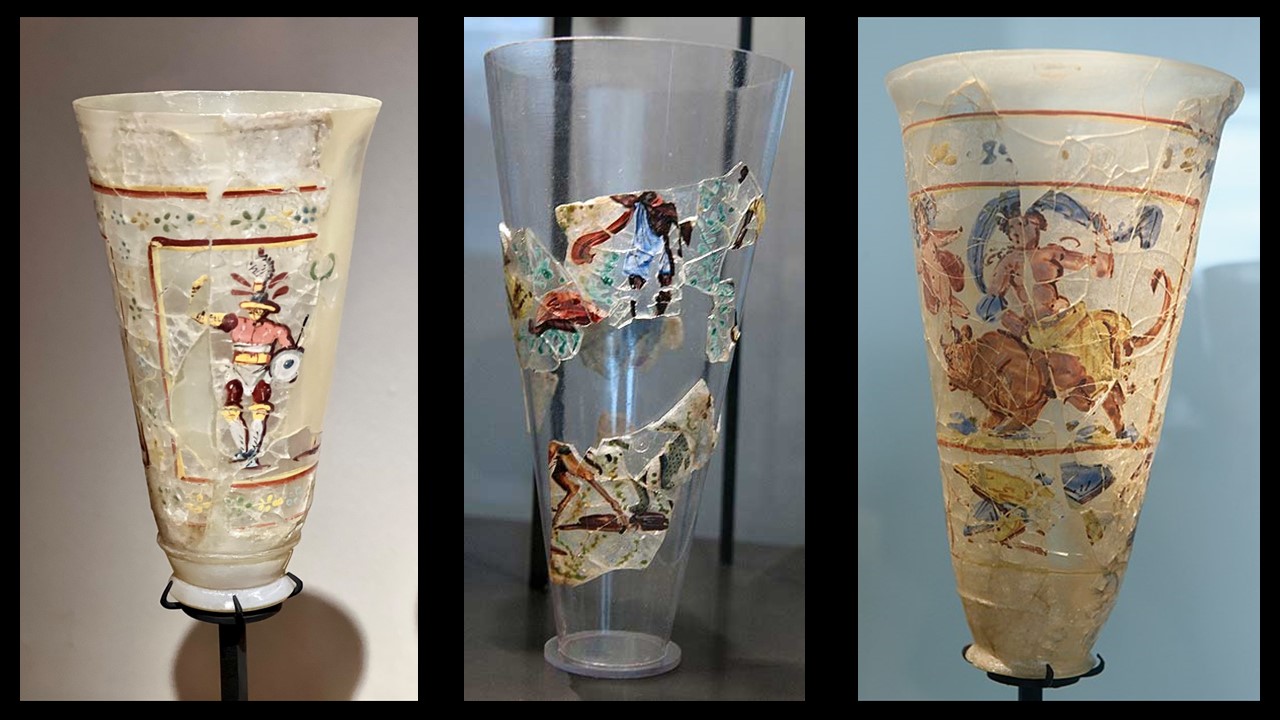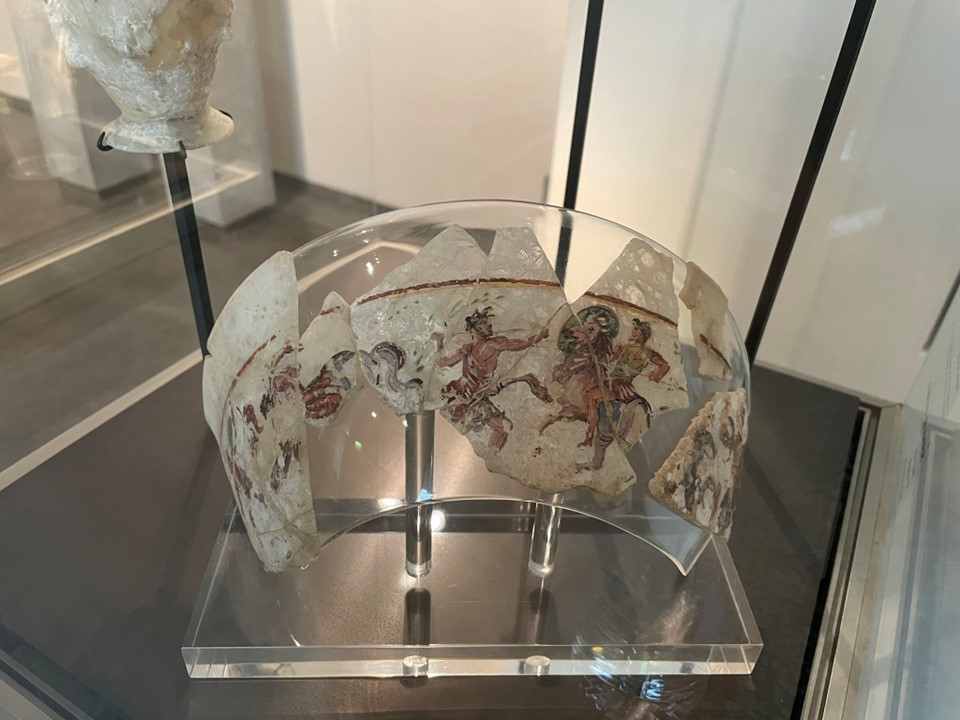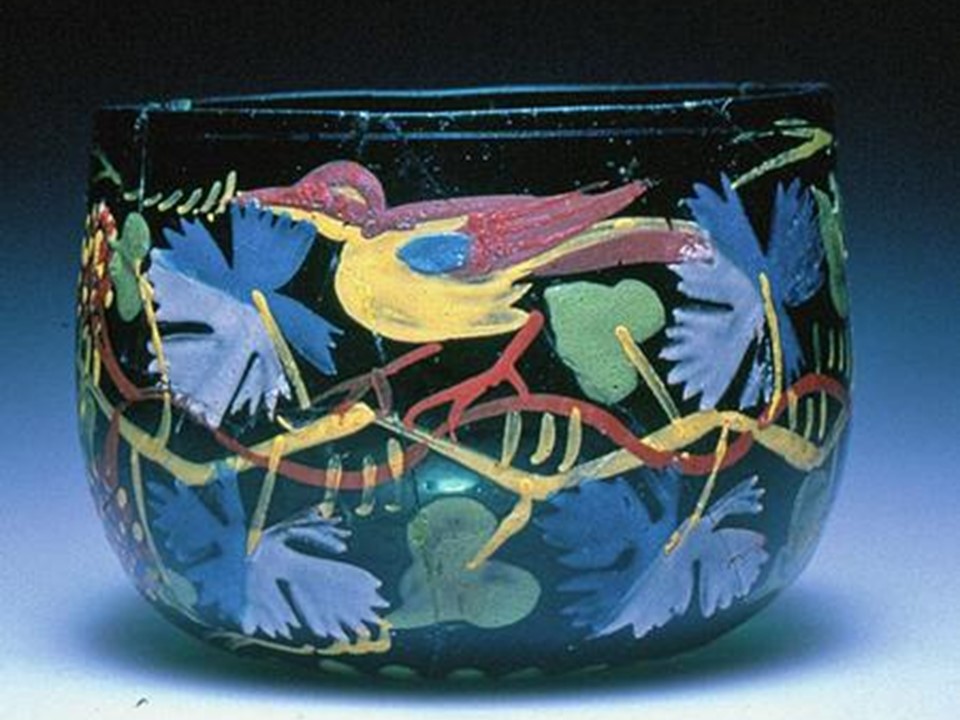
Vase fragment depicting African Hunt, Begram Hoard, 1st century AD, Enameled Glass, Guimet Museum, Paris, France https://depts.washington.edu/silkroad/museums/mg/begram.html
Goblet with the abduction of Europe, Begram Hoard, 1st century AD, Enameled Glass, Height: 16 cm, Guimet Museum, Paris, France https://commons.wikimedia.org/wiki/File:Goblet_Abduction_of_Europa_Begram_Hoard_Guimet_MG21228_n01.jpg
The earliest glass vessel decorated with enameling, write the Corning Museum experts, dates from about 1425 BC. It successfully combines one of humankind’s oldest creative urges (the desire to draw on things) with one of the most advanced technologies of the ancient world (glassmaking). Interestingly, and surprisingly, the next step in decorating with enameling takes fourteen centuries to occur. The absence of enameling on Greek and Hellenistic glass, with no surviving artifacts or documentary descriptions, up until now, directs us to assume that both the concept of this type of decoration and the means to realize it were simply lost and long-awaited rediscovery. All changed during the early decades of the 1st century AD. The gap was bridged, and the technical challenges were achieved. The creation of luxurious Roman Enameled Glass vessels started and lasted over a period of about 300 years. https://www.cmog.org/article/enameled-glass-vessels-1425-bce-1800-decorating-process
Roman enameled glass artifacts fascinate me. They showcase a unique combination of glass craftsmanship and enamelwork, resulting in stunning decorative pieces. While I am not an expert in glass, I am eager to learn. The Corning Museum of Glass website provides valuable information on enameled glass, so allow me to address some questions, starting with “What” and “How.” A valuable addition will be the PowerPoint presentation I have compiled, featuring significant examples of Roman enameled glass artifacts from museums around the world… Click HERE! and judge for yourselves! https://home.cmog.org/ and https://www.cmog.org/article/enameled-glass-vessels-1425-bce-1800-decorating-process
What is Enameled Glass? Enameled glass is a type of glass that has been decorated with a layer, or more, of colored or opaque vitreous enamel. Enamel is a powdered glass material that is mixed with pigments or metallic oxides to achieve various colors and effects. The enameling process involves applying the enamel powder onto the surface of the glass and then heating it in a low-temperature muffle kiln (about 965°-1300°F or 500°-700°C). This heat fuses the enamel to the glass, creating a durable and permanent bond. Sometimes, several firings are required to fuse the different colors of an elaborately enameled object. https://allaboutglass.cmog.org/definition/enamel and Objects and Techniques | The Techniques of Renaissance Venetian Glassworking (cmog.org)
Why did artists use the Enameled Glass technique? Enameled glass is often used for decorative purposes due to its ability to add color, pattern, and texture to glass surfaces. It can be found in various applications, such as art glass, stained glass windows, decorative panels, glassware, and architectural elements. The enamel coating on the glass can be transparent, allowing light to pass through, or opaque, blocking the transmission of light. The choice of enamel color, texture, and design can be customized to suit specific aesthetic preferences or design requirements.
How did Enameled Glass develop, chronologically up and including the Renaissance period, in Europe? A. Roman Period: The discovery of glassblowing during the Roman period made glass affordable and widely available for ordinary domestic purposes. However, the Romans also produced some of the most lavish luxury glass ever made. This is also the time when luxurious glass enamel originated as well. B. 5th – 12th Century AD: The Early Middle Ages saw less advancement in Enameled Glass in Europe due to the fall of the Western Roman Empire and societal changes. There’s evidence, however, of continuous tradition in the Byzantine Empire. C. Late Medieval Period: The first major revival of enameled glass occurred during the late Medieval period. This is also when we see the first instances of stained glass windows in churches, which used enamel for detailed painting and shading. Venice, and the island of Murano to be specific, became the greatest European Glass-making center. D. Renaissance Period: The development of enameled glass greatly increased during the Renaissance. In Venice/Murano, the most important center for glassmaking, artists developed new enameling techniques that allowed for greater detail and more vibrant colours. https://www.cmog.org/article/enameled-glass-vessels-1425-bce-1800-decorating-process
How can Roman Enameled Glass production be described aesthetically? The aesthetic effects of Roman artifacts made from enameled glass can be described as opulent, vibrant, and intricate. These effects were intended to showcase the wealth, status, and refined taste of their owners. The combination of glass and enamel craftsmanship resulted in a unique fusion of materials, creating objects that exuded beauty and sophistication.

The vibrant colors used in Roman enameled glass, achieved through the application of enamel, added a sense of liveliness and richness to the artifacts. The various shades of blues, greens, yellows, reds, and whites created a visually dynamic and eye-catching effect. The colors were often complemented by the addition of gilding or gold leaf, further enhancing the luxurious appearance of the pieces.

The intricate scenes found in Roman enameled glass artifacts showcased the high level of skill and attention to detail of the artisans. Geometric designs, floral motifs, organic patterns, and figurative compositions were meticulously executed, creating a sense of complexity, visual depth, delicacy, and refinement to the overall design.
The layered and multicolored effects, achieved by applying enamel in successive layers, added a sense of dimensionality and complexity to the artifacts. The juxtaposition of different colors and patterns created a captivating visual interplay, drawing the viewer’s attention and enhancing the overall aesthetic appeal.
The aesthetic effect of Roman enameled glass production also reflects the broader artistic sensibilities of the Roman Empire. It embodies the fusion of influences from various cultures, including Hellenistic, Egyptian, and Near Eastern, resulting in a unique and eclectic style that was distinctively Roman.
For a PowerPoint, please… Check HERE!